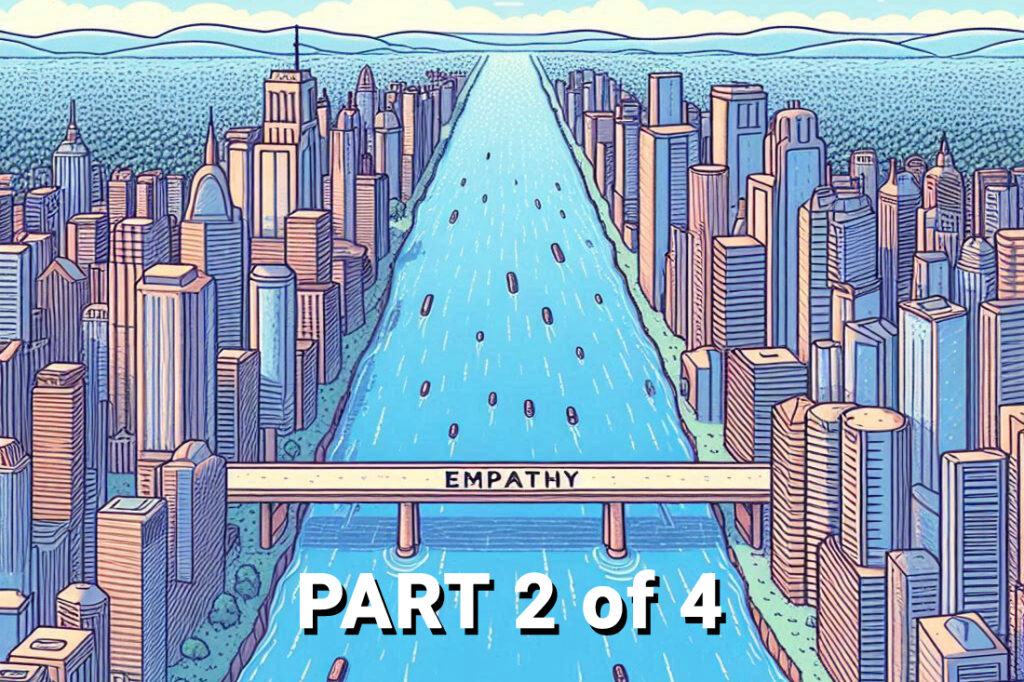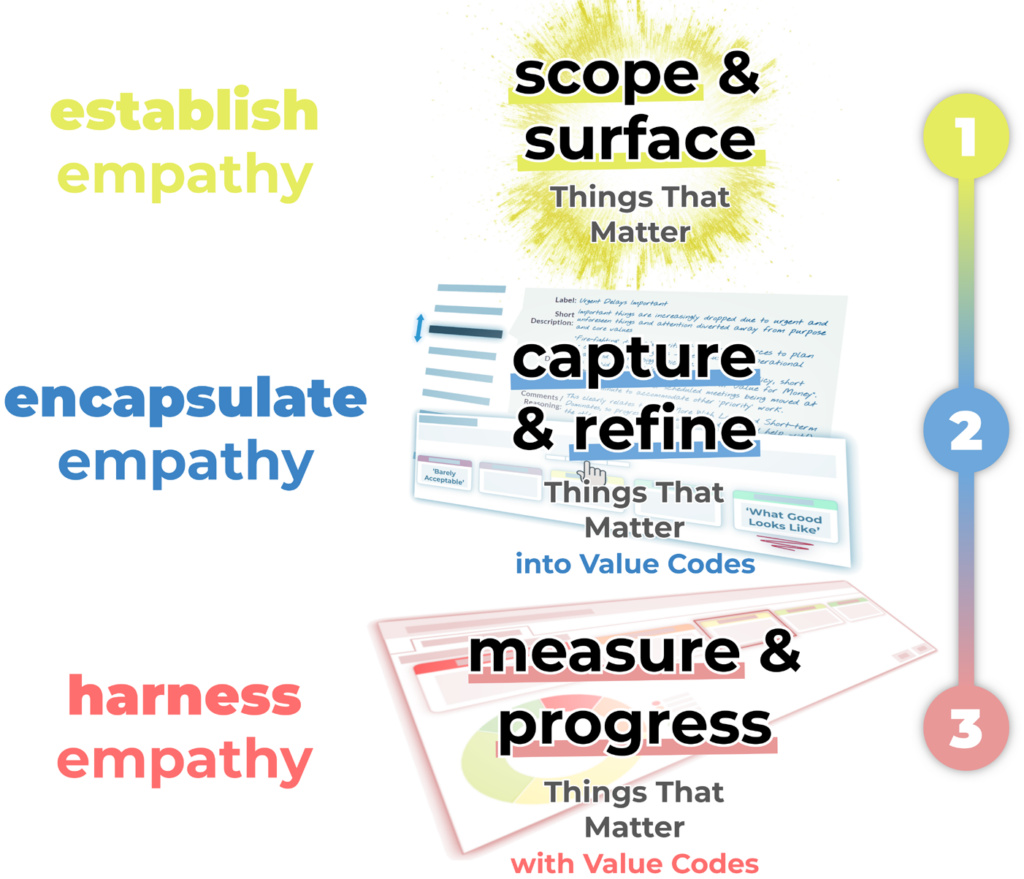Things That Matter: Operationalizing Empathy: Part 2: Establishing Empathy

- Part 1: the Need for Empathy
- Part 2: How to Establish Empathy
- Part 3: How to Encapsulate Empathy
- Part 4: How to Harness Empathy
Empathy is the root of better relationships. We know this on a personal level. But empathy – actively understanding and responding to the other party’s perspective and priorities – is often almost entirely missing between organizations.
In this series, we’re seeing how empathy is based around the Things That Matter – in particular how capturing and making the Things That Matter measurable as Value Codes makes it possible to harness empathy – and in this part, we’ll look at how to establish empathy between organizations.
Last time, we said how empathy “is something we need to develop and can get better at” – especially at an organizational level – and we noted that “it’s going to involve work“.
And what does that work involve when creating the “golden chain” of empathy → understanding → alignment → collaboration → trust? Our Three Step Process.
This Things That Matter process is a process absolutely built on – and around – empathy:

- Step one establishes empathy by surfacing Things That Matter to each party, and then to both parties.
- Step two encapsulates that established empathy, by capturing and then making those Things That Matter measurable – a process we call “Value Coding”.
- Step three then harnesses the power of that established and encapsulated empathy, by measuring and making improvements with the Things That Matter – the Value – in the relationship.
Getting started
So, this first step – establishing empathy – is all about surfacing what matters, and you need to choose a relationship to focus on.
Some guidelines here:
- That relationship should be of significant value to both parties or there’s no shared motivation to improve.
- There ought to be sufficient time left to run in that relationship to achieve change.
- Try and avoid relationships where there are already change initiatives in play: you don’t want to overstretch resources.
- It usually makes sense to start with a relationship that’s struggling: this is where change is most urgent and where success will be most obvious.
With the approach to take, the main suggestion – even if alongside more familiar ways of doing things – is to do something new, both in terms of content and process.
With content, what we’ve found usually works best is to start by looking at issues – what’s not working – as this isn’t an approach people are so used to, and there usually are issues (which often come with a knowable cost in terms of overspend, extra meetings, getting in external help, contract penalties, etc, so potential for clear ROI).
With process, it’s all about engagement: you have to bring people with you, you’re trying to scale empathy, and it also makes sure that nothing is missed.
To meet these combined challenges of “new” content and process, we use online diagnostics, and here are a few examples of the content:

We don’t pull punches in trying to get to the bottom of the situation!
The stages of empathy
But however you do engage people, there are then three stages in establishing organisational empathy.
The first is Internal: understanding and balancing the different perspectives within your own organization to be able to then effectively engage the other party.
The second is External: understanding where the other party is – perhaps beginning with envisaging what things look like from their perspective – but ultimately they’ll need to tell you what matters to them (this is often where the “lightbulb” goes on for people, as there can be big surprises!).
The third is Shared Space: this is where you commit to the Things That Matter to focus on and prioritize together, and this begins with empathy towards the end customer – the Things That Matter to them.
This initial focus on the end customer will help get you out of your own bubbles and focus you back on the purpose of the relationship, after which you’re looking for the Things That Matter to both of you, and at least some things for each of you, individually, as that’s really important for the relationship.
The gaps this plugs
At this point, consider the ways people usually go about finding out what matters to their partners (if they try to do this at all).
Probably the main method is personal conversations, whether between two individuals or in account meetings; after that, chances are that people turn to contracts, assuming these capture the Things That Matter to the other party; or maybe they use surveys, research and industry reports.
Now, all of these have their place, but all of them have issues – how do you spread and scale personal conversations, for example (or what happens when people move on from their roles?) – and what stands out is that all of them are some combination of:
- Just involving a select group (conversations, meetings).
- Top-down (contracts).
- One way (surveys).
- From outside the relationship (research, reports).
- About a single point in time (contracts, surveys, research, reports).
So, nothing people are currently doing involves wide engagement AND being bottom-up AND being two-way AND coming from inside the relationship AND being an ongoing process.
Now compare with the three stages of establishing empathy that we’ve just outlined, and you’ll hopefully see how different it is: it’s about broad engagement; this in turn means it works bottom-up; it’s about open, frank and two-way exchanges; it comes from inside the relationship…
…and it’s part of the bigger Three Step Process that is intended as a repeating and ongoing one.
Traps to avoid
On this note, though, it’s critical to stress that this first step needs to be done properly, and it isn’t an end in and of itself.
On the former, it’s not sufficient to just have a simple conversation or run a workshop exercise – great starts though they are – because the engagement piece is critical; on the latter, you absolutely can’t stop here.
There’s a separate article which covers all this in more depth, but there are two traps to avoid here.
The first is feeling that the “relational” box has now been ticked and you can move on. Absolutely not: you need to act on what you’ve found out, or you’ll lose the goodwill you’ve built up.
The second trap is thinking – in terms of what you do next – that you can just feed what you’ve surfaced into the usual ways you do things, when it’s business as usual that’s played a significant part in getting us into the state we’re in.
So, you need to keep going, you need to keep doing something new, and that means properly encapsulating the empathy you’ve established so far.
We’ll look at that next time.

